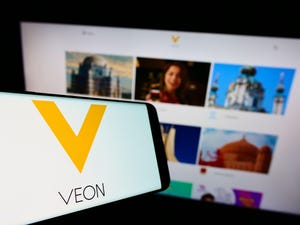Helium Mobile's CEO explains that new Telefónica deal
Telefónica will use Wi-Fi hotspots deployed by Helium Mobile users to augment its cellular coverage in Mexico City and Oaxaca. The deal represents a step toward decentralized wireless (DeWi) technology.

Helium Mobile is a T-Mobile MVNO in the US that has been adding thousands of new customers to its $20 per month unlimited offering. But it's also a decentralized wireless (DeWi) technology company that recently inked a noteworthy agreement with Telefónica in Mexico.
Under that new agreement, Telefónica will basically use Wi-Fi hotspots deployed by Helium Mobile users to augment its cellular coverage in Mexico City and Oaxaca. It will do so by paying roughly 50 cents for each GB that its customers use on Helium Mobile's Wi-Fi hotspots, money that will be funneled through the Helium network's cryptocurrency blockchain to the everyday users who are running those Wi-Fi hotspots.
"I think it's certainly a big deal," Amir Haleem, CEO of Nova Labs (which operates the MVNO), told Light Reading. Nova Labs is the creator of the Helium network and continues to work with the wider Helium Foundation to promote the DeWi model.
"It's a massive win to be able to convince a company like Telefónica to use the Helium network," he said, noting that Helium Mobile officials have been talking to officials from Telefónica for years now. Haleem said longtime telecom executives are skeptical of concepts like blockchain and cryptocurrency.
However, the upshot of the DeWi model is attractive in an industry that's increasingly focused on cutting costs.
"It's not really a sustainable model in my opinion," Haleem said of the telecom industry's traditional top-down network-buildout model. "I think it's starting to break now."
He said he expects more traditional mobile network operators to join Telefónica in supporting DeWi models in the future.
Spreading out the cost of a buildout
"The original vision [of Helium] ... was exactly this," Haleem said of Helium's deal with Telefónica.
Indeed, years ago Nova (then Helium) pioneered the DeWi networking model with its LoRa Internet of Things (IoT) network running in the unlicensed 915MHz spectrum band. As reported by Light Reading, the Helium community managed to grow its IoT network from a handful of transmission sites to almost a million worldwide by the beginning of 2023.
Helium did so by employing a DeWi model that uses cryptocurrency to reward those who deploy and operate transmission sites for the network. Thus, it shifts the cost of building a wireless network from a network operator to, well, just about anyone willing to purchase the necessary equipment. Several other companies – Really, World Mobile, Xnet, Karrier One and others – are in the early stages of developing similar models that promise rewards of cryptocurrency or, in some cases, cash.
For its part, the Helium network is now working to apply its model from its IoT network to a network stretching across cellular operations in the 3.5GHz CBRS band and Wi-Fi operations in unlicensed spectrum. According to the Helium Mobile website, there are now almost 8,000 CBRS radios and almost 4,000 Wi-Fi hotspots supporting Helium Mobile's service. Customers who stray away from those transmission sites can use T-Mobile's network in the US. So far Helium Mobile has managed to sign up more than 36,000 customers to its service.
The Mexican angle
Haleem, the Nova Labs CEO, said that Telefónica is testing out a DeWi model in a few locations in Mexico City and Oaxaca. Mexico hasn't made the CBRS spectrum band available in the same way that US regulators have, leaving Helium Mobile to test out its setup in the more widely available Wi-Fi bands.
"Telefónica is exploring ways to expand coverage through innovative, lower-cost, cooperative-based solutions. This program in Mexico is critical to evaluate performance and customer satisfaction of this solution and its associated costs. Our expectation, if successful, is to incorporate this into our portfolio of mobile networks in the different countries of the region," said José Juan Haro, a top Telefónica executive, said in a release.
The system connects Telefónica's Movistar SIMs to Helium Mobile transmission sites and routes customers' data through Movistar's core network. Movistar customers will be automatically connected to those Helium Mobile sites using the OpenWiFi standard and the Passpoint 2.0 protocol.
Importantly, Telefónica built a network control function that will be tested during the deployment. Further, Helium Mobile transmission hotspots must also be approved by Mexico's telecom regulator, IFT. But ultimately Helium Mobile site operators will be eligible to earn cryptocurrency based on the amount of traffic traveling over their sites.
Counting the cost
According to Haleem, the 50-cents-per-GB cost of data on the Helium network is in part set by the Helium community, based on supply and demand. "So there is a little bit of a question there" about whether the rates should be different, he said.
The process of governing the network is "one of the most complicated questions, honestly," Haleem said. "It's absolutely fascinating."
To be clear though, Telefónica's plan to use Helium's network isn't the first such example of a network operator offloading its traffic onto other operations. In fact, it's relatively common.
For example, large venues like hotels and sports stadiums often build their own indoor wireless networks. Then they work with big public wireless network operators to ensure that their customers remain connected when they roam from the public, outdoor network and into the venue's indoor network.
And Boingo pursued an even more relevant offload model with Wi-Fi operations inside airports and other high-traffic venues. It ultimately managed to get Sprint and AT&T to sign up for its Wi-Fi offload option.
But Helium is somewhat unique in that it essentially encourages everyday users – whether they be apartment residents, coffee shop operators or others – to build and operate its network.
About the Author(s)
You May Also Like












